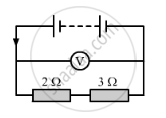Advertisements
Advertisements
Question
Solution
Precautions while using electricity:
(i) One must use wires or cables of current carrying capacity higher than the current which can flow through the circuit while using all appliances.
(ii) An electrical appliance must never be operated (or touched) with wet hands.
APPEARS IN
RELATED QUESTIONS
Draw the electrical symbols of the following components and state its use:
Rheostat (variable resistance)
What actually travels through the wires when you switch on a light?
In the circuit shown below, the voltmeter reads 10 V.

(a) What is the combined resistance?
(b) What current flows?
(c) What is the p.d. across 2 Ω resistor?
(d) What is the p.d. across 3 Ω resistor?
Draw a circuit diagram showing two lamps, one cell and a switch connected in series.
How can you change the brightness of the lamp?
A wire of length 5 m has a resistance of 2.0 Ω calculate:
(a) the resistance of wire of length 1 m
(b) the equivalent resistance if two such wires each of length 2 m are joined in parallel.
(c) the resistance of 1 m length of wire of same material but of half diameter.
In the circuit shown in fig. 6, find the reading of the ammeter A when the switch S is
(a) Opened.
(b) Closed.

Three heaters each rated 250 W, 100 V are connected in parallel to a 100 V supply. The resistance of each heater
Three heaters each rated 250 W, 100 V are connected in parallel to a 100 V supply of the energy supplied in kWh to the three heaters in 5 hours.
Three resistances, of which two are equal when connected in series have an effective resistance of 30 ohms. When the three resistances are connected in parallel, the effective resistances is 3 ohms. Find the values of the individual resistances.
Assertion (A): Electric current will not flow between two charged bodies when connected if their charges are the same.
Reason (R): Current is the rate of flow of charge.
